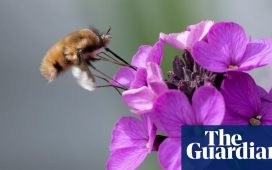Getting stuck into the in-flight wine wasn’t an option for the 30 passengers flying overnight from South Africa to Rwanda. Crew members instead worked to keep the first-time air travellers placid and problem-free. The last thing anyone wanted was a 1.5-ton rhino on the rampage aboard a Boeing 747.
“All the rhinos were slightly sedated to keep them calm and not aggressive or trying to get out of the crates,” said Jes Gruner, of conservation organisation African Parks, who oversaw the largest single rhino translocation in history this weekend. “The rhinos weren’t sedated on the plane in the sense they were totally lying down, as that’s bad for their sternums. But they were partly drugged, so they could still stand up and keep their bodily functions normal, but enough to keep them calm and stable.”
The 30 white rhinos arrived at their new home, Akagera national park in eastern Rwanda, yesterday. It is hoped Akagera will become a new breeding stronghold to support the long-term survival of the species. Down to an estimated 18,000 animals across Africa, white rhinos are classified by the IUCN as near threatened, with numbers in decline largely due to poaching, driven by demand for their horns.

“It’s absolutely vital to get white rhinos spread across the continent, where they have safe habitats, and not necessarily only where they used to be,” Gruner said. “We need to spread the risk. If some countries can’t get hold of the illegal wildlife trade, white rhinos and rhinos in general might be pushed to the brink of extinction. We have to do everything we can to address their safety.”
Unlike critically endangered black rhinos, which previously roamed in Rwanda, white rhinos are a new introduction to the country. “We’re starting with 30, but this could grow – Akagera could be a home for easily 500 or 1,000 white rhino in the future,” Gruner said. “It could be a good genetic pool. We refer to it as an ‘animal bank’, where you can keep wildlife for the future movement of animals within the region, once we have a good, breeding, functional population in Akagera.”

The rhinos – 19 females and 11 males, a mix of adults and subadults – were driven from Phinda private game reserve in South Africa’s Munyawana conservancy, flown from Durban to Kigali, then transported by road to Akagera, completing a 40-hour journey of more than 3,400km – a massive logistical undertaking that went ahead despite the new Covid variant announcements over the weekend.
“This move is the first of its kind with so many animals from wild to wild,” said Gruner. “It’s been a huge task. We chartered an aircraft. There was over 60 tons of animals, crates and feed; a logistical operation that’s taken six months to get going, but at least three years to organise. We’ve had the rhinos in a quarantine area for two months. It’s also one of the longest trips ever done. This move sets the benchmark for future white rhino conservation.”
Security was key. “We definitely didn’t promote where they were in quarantine in South Africa,” said Gruner. “They’ve been dehorned because, where they’re from, being dehorned is a deterrent to poachers. There was security for the animals along the way in South Africa, and in Rwanda, the government supported us hugely with national police escorts. We’ve had to uplift law enforcement within the national park, including monitoring. But we also want to show other countries and NGOs how this move can be done – if we can get that right, there is hope for white rhinos. So we won’t be silent about it.”
The project is a collaboration between African Parks, the Rwandan government’s Rwanda Development Board and safari company &Beyond, with funding from the Howard G Buffett Foundation. Akagera has been managed by African Parks and the Rwanda Development Board since 2010, with previous reintroductions of lions in 2015 and black rhinos in 2017 and 2019.

“Akagera is the right spot,” said Gruner, explaining the choice of location. “There’s plenty of habitat around the continent, but not necessarily safe habitat. The government of Rwanda has shown their seriousness in conservation and protection in the last 15 to 20 years. It’s been proven – with the reintroduction of 18 black rhinos in 2017 and five more from zoos in Europe – that we can keep them safe. To date, no rhino has been poached, and the growth rate has been positive. That sets the mark for the white rhinos.”
The white rhinos are the latest step in a plan to revive the national park. “Akagera was a large part of my youth, with my family spending time camping in the wilds through the 1970s,” said Ladis Ndahiriwe, park manager of Akagera. “Back then, Akagera was very wild, with over 300 lions. There were drastic changes in Akagera in the 1990s from the pressures of refugees coming back home after the genocide against the Tutsi. It was a time of great upheaval and pain. Akagera is almost unrecognisable today, with all key species numbers increasing. Before Covid, the park was 90% self-financing through tourism. The white rhinos arriving is a point of pride for us and for Rwanda. We’ve created a safe haven that can protect this species for the future.”
Gruner said: “We look forward to the day when we have some white rhino calves in Rwanda – ‘first generation’ Rwandan white rhinos. The day they start multiplying in number, we know this has been a successful project.”

Find more age of extinction coverage here, and follow biodiversity reporters Phoebe Weston and Patrick Greenfield on Twitter for all the latest news and features







